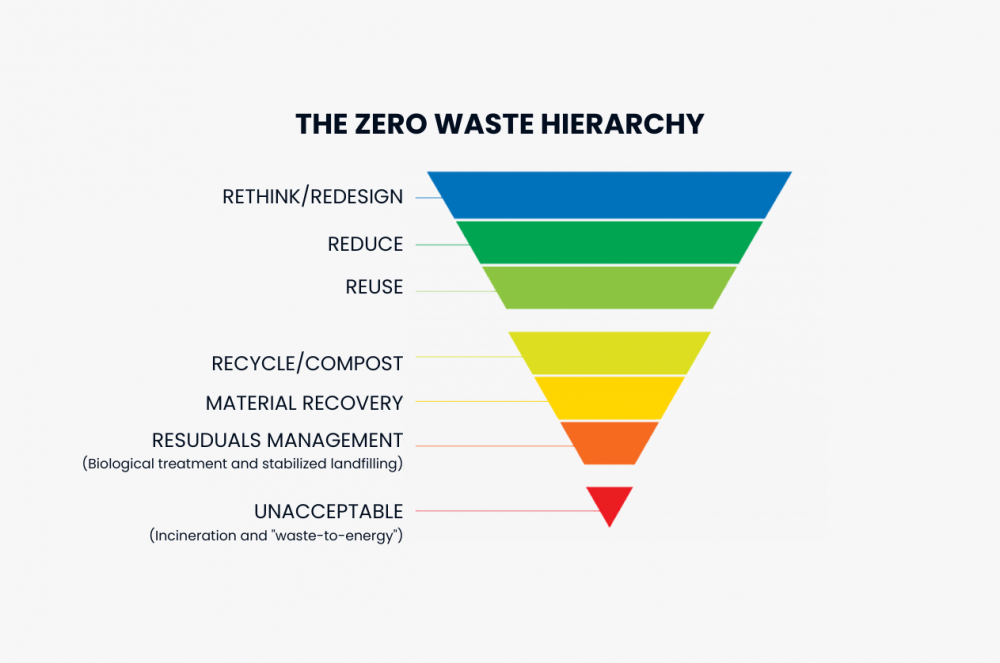We’ve all heard the saying, “Reduce, reuse, recycle”. These actions are meant to be done in that order: first, we reduce our consumption as much as possible; then we reuse what we can; and finally, we recycle what’s left over.
This is a simplified version of the waste hierarchy, or waste pyramid, which tells us the best way to manage our waste so we can preserve the most value in the materials. What all waste pyramids have in common is that they show the order of preference for waste management options so we can make the smallest impact on the environment and preserve the most value in the materials. We can think of this as a series of filters; the top level catches (or prevents) as much waste as possible, leaving less waste to move along to the second tier, and so on. However, in the modern waste hierarchy, there are often more than three possibilities.
The Zero Waste International Alliance (ZWIA)
The Zero Waste International alliance (ZWIA) identifies seven steps:
1. Rethink/redesign
The first level focuses on preventing waste generation, either by designing waste-free systems or by ending the sale of single-use items that can be easily replaced with alternatives.
2. Reduce
The second level of the non-waste hierarchy focuses on expanding the market for used items that have not yet become waste, which are underutilized assets in our economies. The goal is to prevent them from going to waste and instead find ways to reintegrate them back into the economy.
3. Preparation for Reuse
The third level of the Zero Waste hierarchy deals with waste by focusing on preparation for reuse. This involves cleaning, repairing, and refurbishing waste items to turn them back into usable products, following the second level of the EU waste hierarchy.
4. Recycle/compost
The fourth and final level of the hierarchy is focused on transforming separately collected waste into high-quality secondary raw materials, which should be the last resort for sustainable resource management. This level aligns with the third level of the EU waste hierarchy.
5. Material recovery
The Zero Waste hierarchy differs from and complements the EU waste hierarchy in its approach to the lower levels. While the EU hierarchy prioritizes energy recovery after recycling, the Zero Waste hierarchy emphasizes the extraction of valuable materials from mixed waste and sorting processes. This aligns with the principles of Circular Economy, which aims to keep materials and resources in circulation, while thermal treatment is seen as a loss of resources. Systems with high rates of separate collection, as required by new EU waste legislation, provide a cost-effective way to retain resource value and minimize disposal through material recovery and biological treatment of mixed waste. New technologies for chemical recycling that transform used polymers into new materials also fit within this level, as long as they are used on waste from sorting processes and not separately collected streams.
6. Residuals management: Biological treatment and stabilized landfilling
Current EU waste legislation requires the separate collection of waste streams, which diverts the majority of biologically active waste away from residual waste. Through preliminary biological stabilization, this waste can be safely disposed of in compliance with the Landfill Directive and related pre-treatment requirements. These systems are designed to handle increasing amounts of source-separated organics and decreasing amounts of residual waste. Europe’s future transition towards waste-free systems by design, as outlined in levels 1 and 2, is expected to significantly reduce residual waste and will require adaptability to meet the changing landscape.
7. Unacceptable: Incineration and waste-to-energy
The new hierarchy considers options that create obstacles to the transition, waste resources, or are environmentally harmful as unacceptable. Landfilling unstabilized waste, littering, and combustion or co-combustion of mixed waste are outdated practices that clash with the EU’s decarbonisation goals and divert investment from higher levels of the hierarchy.
The European Union (EU) Waste Framework Directive
The European Union (EU) Waste Framework Directive condenses this into five steps:
1. Prevention
2. Preparing for reuse
3. Recycling
4. Recovery: Includes incineration to produce energy
5. Disposal: Includes landfilling
What are the differences between The Zero Waste International Alliance (ZWIA) and the European Union (EU) Waste Framework Directive
While these two hierarchies are similar, they do differ in certain respects, including the order of preference of landfilling and incineration. Both waste treatments cause significant environmental damage, and the choice is a matter of priorities and the details of the treatment. The EU pyramid prefers incineration with energy recovery over landfilling. Incineration with energy recovery has the benefit of potentially replacing fossil fuel-based energy sources, although in Europe energy produced by incineration is roughly twice as carbon intensive as the average grid energy. All incineration reduces land demand compared to landfills while also preventing landfill methane emissions.
The ZWIA pyramid, conversely, prioritizes a minimal degree of landfilling—but only after biological stabilization to address methane emissions, and partnered with a careful evaluation of the potential for future waste reduction—over incineration, which it deems “Unacceptable”. The reasons given are that incineration locks in demand for waste; the capital expense of building an incineration facility is only worthwhile if it continues to make money by burning waste. If the heat produced by combustion is used for energy, this also develops dependence in the energy grid.
UBQ’s Place in the Waste Pyramid
UBQ Materials was conceived as the recycler of last resort. In fact, UBQ technology was designed to up-cycle mixed residual waste that is aimed to landfill. Therefore, far from competing with existing recycling systems, UBQ complements it. We make a valuable thermoplastic material (called UBQ™) out of mixed residual waste, including all organics. Residual waste is the materials that were not collected by any recycling system—either because they are unrecyclable, it’s not economical, or there is simply no recycling or sorting systems in place. Accordingly, any materials left over that can be recycled using conventional methods (including PET, metals, and minerals) are removed from the residual and sent to recyclers before being converted to UBQ™. In accordance with the waste hierarchy, the highest and best use is prioritized for all materials.
UBQ’s place in the waste pyramid is at the bottom, by design—the lowest possible tier that allows for the reutilization of materials. The only alternative end-of-life treatments to mixed residual waste are those where waste is truly wasted, incineration and landfill. In the ZWIA waste pyramid, UBQ belongs in tier #5, ‘material recovery’. This tier is distinct from recycling and composting and applies only to the mixed residues that are left over after those processes.
Applying the Waste Hierarchy
We at UBQ Materials heartily support all efforts to prevent the creation of waste in the first place, including redesign, reduction, reuse, repair, and refurbishment. We don’t advocate buying things you don’t need, even if those things do contain UBQ™. If you do need an item, we encourage you to borrow it or buy it secondhand if possible. If, and only if, it is necessary to buy a new product, this is when we recommend paying close attention to the materials—their recycled content, the carbon footprint if the information is available, and their recyclability when the product’s useful life is over. Many members of our team diligently follow these principles in our daily lives.
Once products have been manufactured, used, and disposed of, they enter the waste management system. All materials that may be recycled or composted, depending on local capabilities, should be sorted and collected separately to reduce contamination and maximize the recovery of valuable materials. It’s only after this that UBQ steps in—requiring no behavior change from residents or consumers—and gives new life to the materials that we’ve treated as worthless for far too long.


